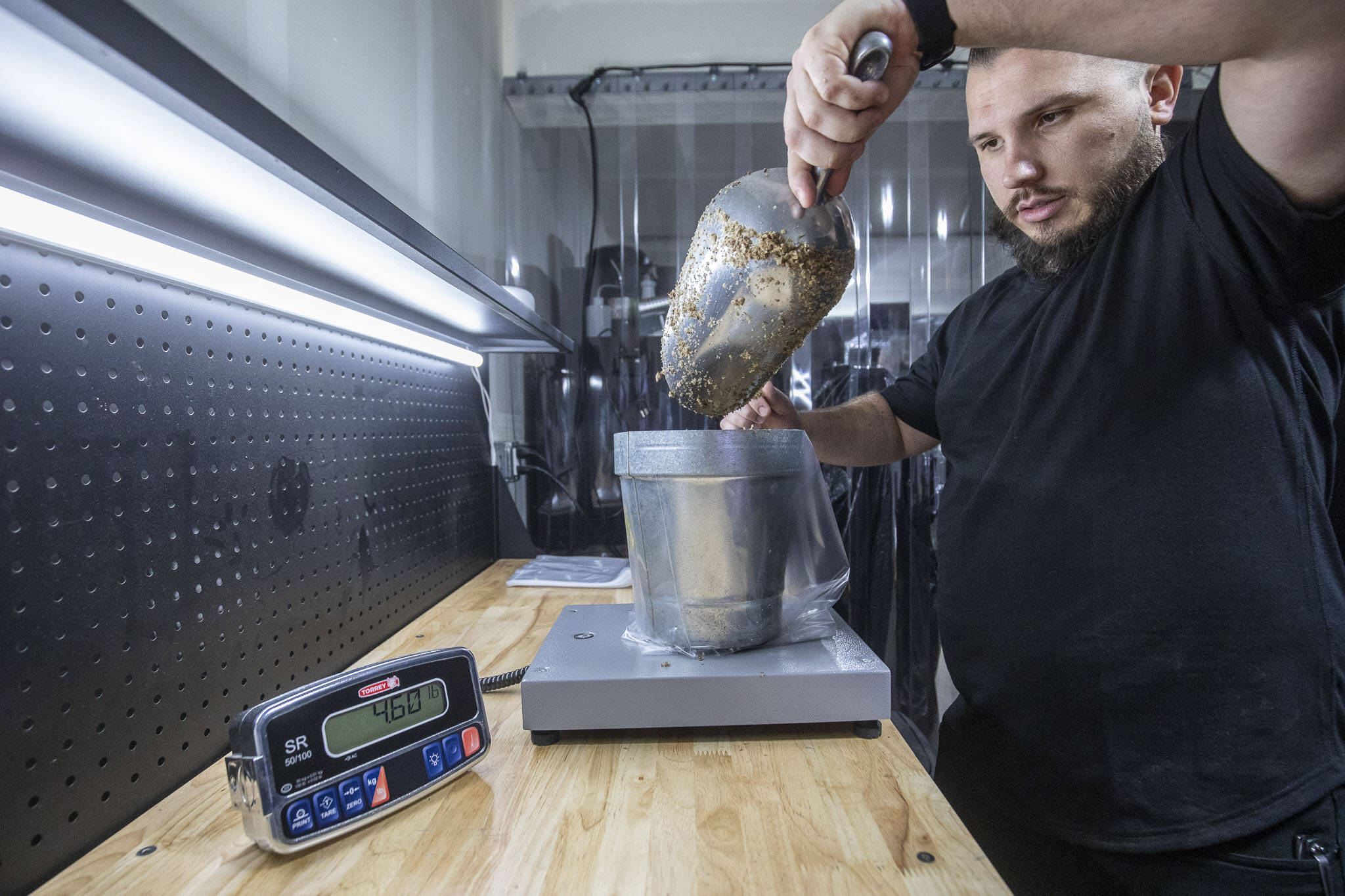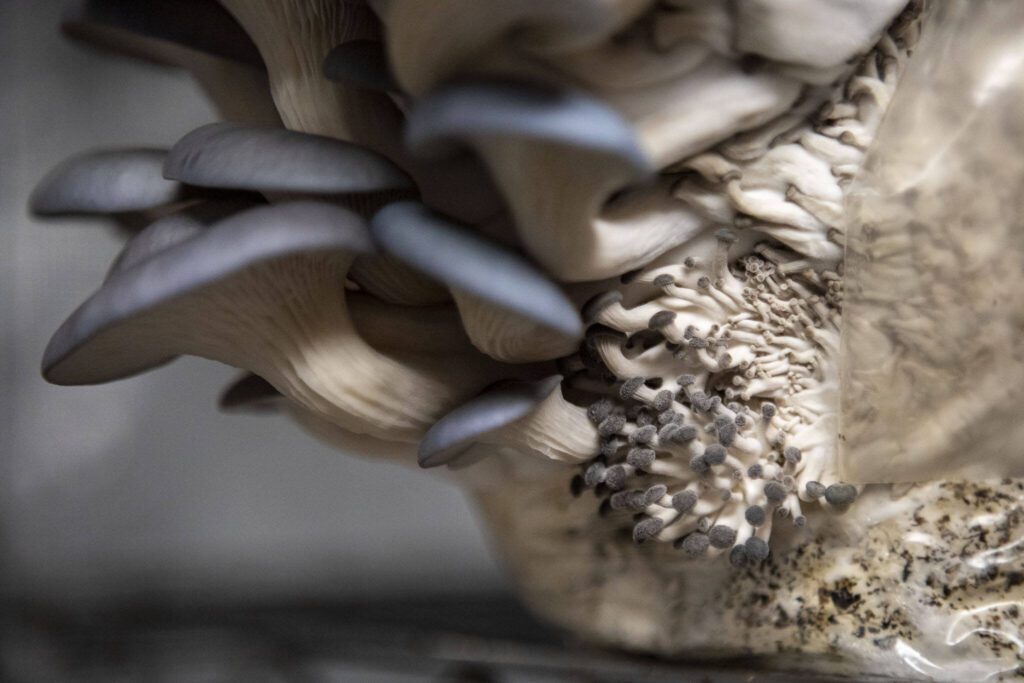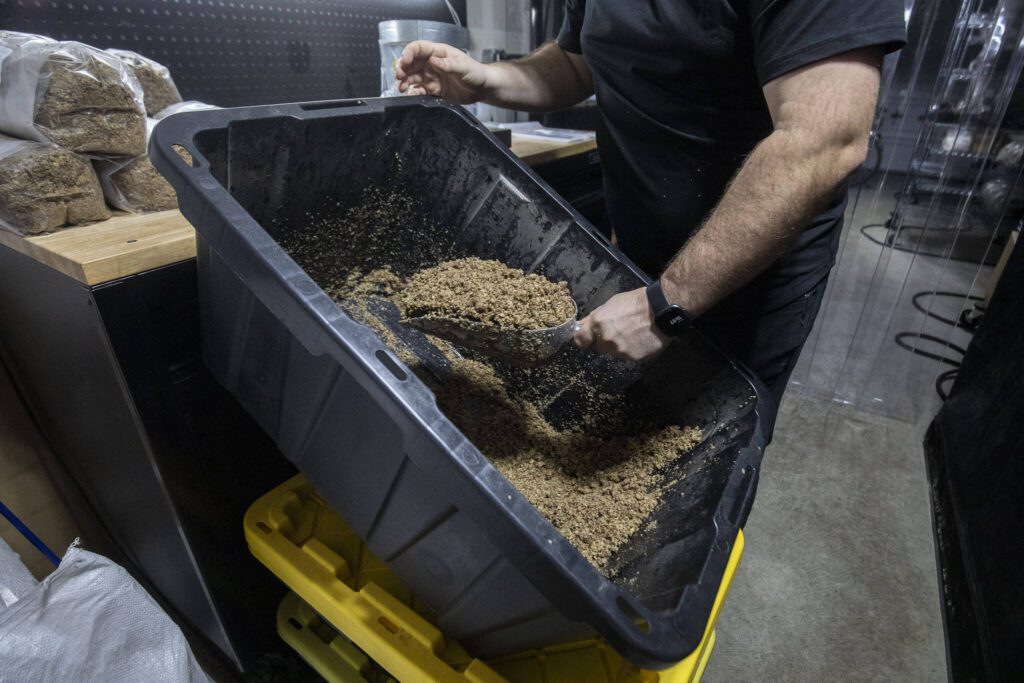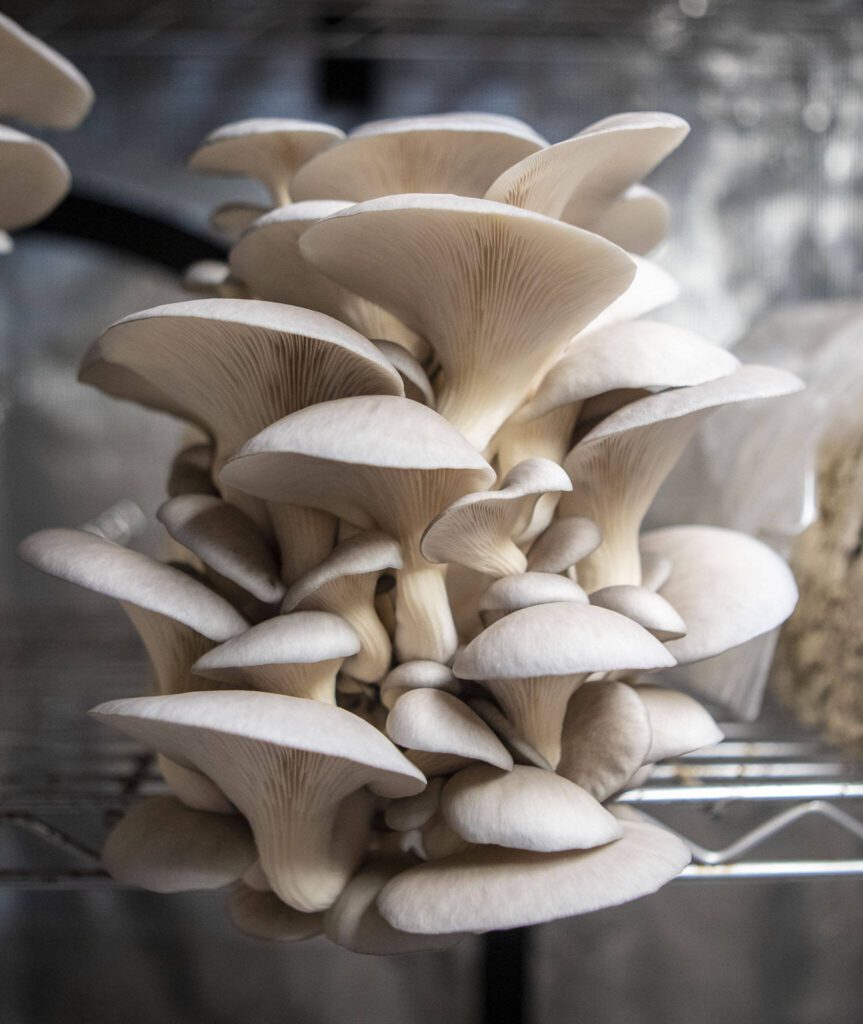If the mushrooms had eyes, they would realize this is not the forest. Their squeaky clean bodies grew not from wet leaves or manure or rotting trees, but rather inside an 8-by-8-foot tent off a quiet street near the Snohomish River in Everett, where an Air Force veteran cultivated an entire farm out of a 300-square-foot garage.
Outside the mushrooms’ fruiting chamber, a man-made habitat contains all the things responsible for their birth: an autoclave to sterilize their diet of dry grain and soy, an AC unit to manage the temperature, a fridge holding the beginning of them — syringes full of liquid culture. Nathanael Engen built the humidifier himself (it saved him a few thousand bucks) to keep the air perfectly moist.
Engen’s controlled-environment agriculture system ensures his chosen fungi are the only organisms growing. His mushrooms carry no scars from the elements or insects or pests, no dirt embedded in their stems or mystery bites on their caps. Blue oysters, one of Engen’s bestsellers, look like something out of a Dr. Seuss book: Their pristine, thick white bodies curve whimsically skyward, boasting intensely dark blue caps when they first fruit. Like humans, they gray as they age.
The grower talks to his mushrooms.
“It’s an energy you put out there,” said Engen, 34.
“You guys are looking so good,” he tells them, as he inspects each of the nutrient-packed blocks where they grow. Engen’s girlfriend peels back the tent’s window and chimes in, “Hello, friends!”
Black Forest Mushrooms is in many ways incomparable to nature, yet Engen’s business has been painstakingly designed to mimic it. This, the mushrooms would quickly realize, is all a simulation.
Here, the mushrooms do not release their spores into the wild. They don’t decompose or become a meal for chomping gnats and beetles. Instead, their bouncy, light bodies are plucked from their growing blocks and seared until slightly crisp and caramelized in a hot pan (if the cook knows what they’re doing; Engen does), until they are nutty, slightly meaty and deeply savory, with salt, olive oil and thyme as their only companions in death.
Within the substrate where Engen grabbed the blue oysters, a vast system of long branching filaments, much like the arteries that pump nutrients through our bodies, prepares the next harvest.
Growing the fruit
A Black Forest mushroom’s journey begins inside a fridge Engen picked up from a Mexican restaurant. He pulls out syringes containing liquid culture from the mushroom’s spores, then carefully drops it inside petri dishes, where the spores grow and spread like the roots of trees, neural pathways, tiny white galaxies.
He divides the plate into wedges and introduces each one to hydrated, cereal-scented rye grain, sterilized by the autoclave.
“This environment is highly nutritious, so we want to make sure the only things growing in the production block are the spores,” Engen said.
After he inoculates the grain, the spawn colonizes, eventually penetrating every nook and cranny to form a vast thread of fungal networks called a mycelium. Think of the mycelium as the root of most fungi.
“You have to grow the apple tree before you get the apple, just as you have to grow the mycelium to get the mushrooms,” Engen said. “When the mushroom grows, that releases spores, which is about equivalent to seeds in the apples.”
Separately, Engen soaks and sterilizes a master mix of soybean hulls and hardwood sawdust that will serve as the fungi’s substrate — what it grows on. That mix carries what mushrooms need to thrive: carbon from the wood and protein from the soy by-product.
(Fungi, by the way, digest nutrients outside their body by secreting enzymes that break down the organic material, then take in small molecules and use them in metabolism. Imagine you don’t have a stomach: Instead, you digest a big steak all over your body, then absorb it through your skin.)
He seals the production blocks in plastic grow bags (Engen plans to switch to biodegradable plastic bags within the next few years, as well as introducing other carbon offsets), allowing the mushrooms to breathe filtered air while keeping contaminants out.
Once the bag cools off, it’s time for incubation. The spawn will grow through the substrate for the next two to four weeks. The goal in this warmer environment, mimicking fungi’s typical season of growth, is for the mycelium to overtake the entire production block, flooding its cells with nutrients so it can spread rapidly.
Several weeks later, Engen moves them out of incubation, slices open the production blocks and places them on racks in the fruiting chamber. Exposed to cooler air, more light intensity, the right humidity and CO2 levels) the mycelium begins to form fruiting bodies—what we eventually eat.
Growing mushrooms is a giant endeavor of tiny necessities. During every step, Engen walks a fine line between the perfect conditions and contamination.
“When we go into the lab, we are the dirtiest thing in that lab, even if we just showered,” Engen said.
Without cleaning constantly and sterilizing, microscopic enemies hang in the air and in the mushroom’s nutrients, capable of contaminating Engen’s crops. Imagine scattering seeds in a field without preparing the soil: You’ll get some growth, but your farm will lose a significant portion of the crop to pests.
The grower can carry his farm’s worst enemies in his own lungs. We breathe in, and out, thousands of fungal spores every day — one of the reasons Engen runs such an (air)tight ship.
“We listen to music while cleaning, but we don’t sing, even with a mask on,” he said. “You can see the difference in your contamination rate.”
Black Forest Mushrooms hits capacity at several hundred pounds. One block can produce up to three flushes—the crop that is harvested—and will yield a few pounds. Any agricultural waste from the substrate is given another life by being composted or donated to garden centers, a tenet of Engen’s sustainability-rooted business.
Inside the fruiting chamber, an overhead light shows racks of dark, youthful blue oysters alongside chestnut and lion’s mane mushrooms that he’ll sell fresh at farmers markets in a few weeks. Engen also sells fresh king oysters and shiitakes, lion’s mane powder, dried blue oyster and grow kits — so far.
“The entire process from spore to this bad boy,” he said, pointing to the vertical field of fruited mushrooms, “is about two months.”
The first time the chamber was full of perfectly grown mushrooms was in the fall of 2021. Three varieties had fruited all at once.
“It just kind of hit me,” he said. “I remember standing in the room, and I was like, this is going to work. This can honestly work.”
A startup of ‘mystical beings’
In November, Engen’s mushrooms were growing slowly, too slowly to make it to the upcoming Snohomish Harvested Holiday Market, despite his meticulous schedule.
“I thought I cut them in time,” he said, looking at the too-small caps. “I’m a little worried. But they will get sold.”
Owning any startup will have the most determined entrepreneur feeling spent and unsupported. Securing enough funds to scale can be a catch-22, Engen said: You need money to grow, but you need to grow to get money, and growing isn’t even always enough to grab investors. He needed to hire more employees and secure a warehouse so he could impress would-be partners by scaling and showing more liquidity in the business.
“And that costs money,” Engen said.
Finding people who truly believed in what he was building — investing in the local food supply chain, fighting climate change through sustainable farming methods, providing a valued business to the community — is a tall order. Within the first year, Engen felt stuck between wanting to grow and meeting major expectations of high returns.
“You’re dealing with the time constraints of securing funds, going through hurdles without the guarantee of funds, and dealing with restrictive policies,” he said in November. “I’m exhausted.”
And he’s in it for the long haul.
Within the next two months, Engen secured some investors who were committed to his goals—not only for growth but to nourish his vision of cultivating both gourmet mushrooms and healthy communities. The type of people who would ask, “What else can I do to help?”
“That’s the type of investor we’re grateful to have attracted, so far,” Engen said.
In early 2023, Black Forest Mushrooms was slated to move into a 3,000-square-foot warehouse in downtown Everett, where Engen would have combined his mushroom farm with a retail store and demonstration kitchen.
That location ended up not working out. He’s still searching for the right place. In the meantime, he expanded his current space to 460 square feet. He also hired his first employee and together, they’re honing their craft.
“It’s pros and cons,” Engen said. “We’re slowing down and doing things right.”
Engen has been an entrepreneur since at least 14, when he started a mowing business after a neighbor spotted him cutting his parents’ lawn and joked, “Why are you making me look so bad?” The then-teen saw a demand and eventually franchised, hiring a friend to cover more ground. After his four-year deployment in the Air Force, Engen pivoted from a failed venture in concert production to urban farming.
He first experimented with controlled environment agriculture in his and his girlfriend’s Seattle apartment in 2019, taking over a quarter of the living room to grow plants like tomatoes and microgreens (the too-big-for-an-apartment-living-room zucchini plant was not a good idea).
“I had purchased this ugly rack, put all of the lights and airflow on it,” Engen said. “My girlfriend, bless her soul, was so patient with me.”
The zucchini grew well, but Engen kept gravitating toward fungi. The mushroom business ticked his entrepreneurial and sustainability must-haves: High demand? Check. Low supply? Check. Expandable and diversifiable? Double check. Positive impact on the local and global community? He was committed.
Bonus points, according to Engen: Mushrooms are “mystical beings, the unseen heartbeat of the forest.”
Some fungi live as fermenters, orchestrating the enticingly funky profiles of cheese and beer. Certain decomposers can even break down plastic. Edible mushrooms like king oysters are fantastic in a garlic white wine sauce fattened with butter. Inedible ones can wipe out your liver and kill you.
He’d research them late into the night, often going so far down the mushroom rabbit hole he wouldn’t come up until the birds started chirping.
After a few all-nighters, Engen thought, “What if that’s the only crop I grew?”
‘A sign of death and life’
Across the country, more than a decade before he grew his first mushrooms, Engen cared for the families and remains of fallen service members at Dover Air Force Base in Delaware.
During a dignified transfer, servicemen carry bodies in silver cases impeccably draped with American flags off a plane and across the tarmac into a transfer vehicle. The remains go to the base’s mortuary, where Engen served, before arriving at their final resting place.
Engen also watched over the Fisher House, where families stay during the dignified transfer of their loved one. He cleaned the house diligently, made it brand new over and over, ensuring every family member who entered was taken care of. He was on standby to grab milkshake supplies at the grocery store, or buy McDonald’s at 2 a.m. for anyone who requested it.
His duties were split between listening to loved ones’ stories and helping prepare bodies for burial.
“The crossover between working with the remains and then talking to the families, having them show me photos. It was doing both that really just…” Engen paused, wiping away tears. “I’m an empathetic person and it just sucks. To see guys come in who were younger than me. That was it for them, for their family.”
Engen said he was mentally prepared and properly trained when he entered the base at 23. He doesn’t regret his service. Based on what family members told him, Engen made an impact on many lives.
“But man,” he said, “I remember there was this storage closet — they told us we cannot cry in front of the families, so to bottle those feelings up…I would just sit in there and cry.”
Years after he finished his deployment, Engen sat in a hospital room, where he’d just been diagnosed with post-traumatic stress disorder.
“Now I’m trying to figure out what I’m going to do with my life, and is it even worth doing anything with my life, if I’m just going to die anyway?” Engen asked himself.
“What can we do with the time we have on this planet?”
Fungi appeared over one billion years ago. They have a quiet power beneath the forest floor, coexisting with trees by combining their mycelium to the roots so both organisms gain more nutrients. They are survivors, one of the five biological kingdoms, helpers of other species.
“Mushrooms are both a sign of death and life,” Engen said. “They show up as a sign of life after something dies. They’re redistributing nutrients throughout the forest. There is a system, there is a process.”
Engen first got a taste of working the earth on his uncle Rudy Salas’s Colorado farm in his teens. He taught Engen about agriculture, working with cows and growing hay, the grind of building a business, the reward of watching the things you fostered finally grow. Engen would wake up with Salas before sunrise to work the farm, then during business hours they were carpet cleaners. They came home, made sure the cows and horses were fed, had dinner and headed out again as night shift janitors. They slept a few hours then did it all over again.
Salas died of prostate cancer when Engen was 26. He’d just returned home from the military and was decompressing when he got the call.
“He worked so hard. He did it for his family,” Engen said. “I don’t really regret much in my life, but I do wish I would have spent time with him in his final days. But I’d made a commitment to serve.”
When he was very young, Engen watched his Grandma Am plant tomatoes and flowers in her garden every spring. He was seven when she died. He felt her death in an immense way as a child, the awful permanence of it.
Twenty-seven years later, the veteran washed his hands and slid on gloves.
“This is the way of life. People do die. Even if we removed everything I saw in the military, we’re still going to die,” he said. “What are you going to do? Are you gonna sit around and wait to die, or are you gonna make the best of it?”
After being diagnosed with PTSD, Engen was able to seek proper treatment.
“You don’t really fully recover from it,” he said, “but it’s something you learn to live with, and strengthen your mental capacity.”
Mouth shut and music blasting, he stepped inside a tent brimming with rows of spotless fungi. There, Engen tended to his garden.
Where to find Black Forest Mushrooms:
Snohomish Farmers Market: Thursdays from May to September
Lake Stevens Farmers Market: Wednesdays from June to August
Shoreline Farmers Market: Saturdays from June to October
Woodinville Farmers Market: Second Saturday each month from May to September
Find Black Forest Mushrooms grow kits at Petrikor, 2816 Rucker Ave, Everett.
Black Forest Mushrooms plans to expand to restaurants and other local businesses. Stay tuned.
Facebook: https://www.facebook.com/Black.Forest.Mushrooms
Instagram: @black.forest.mushrooms
Talk to us
> Give us your news tips.
> Send us a letter to the editor.
> More Herald contact information.






























